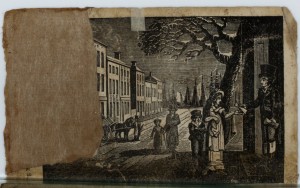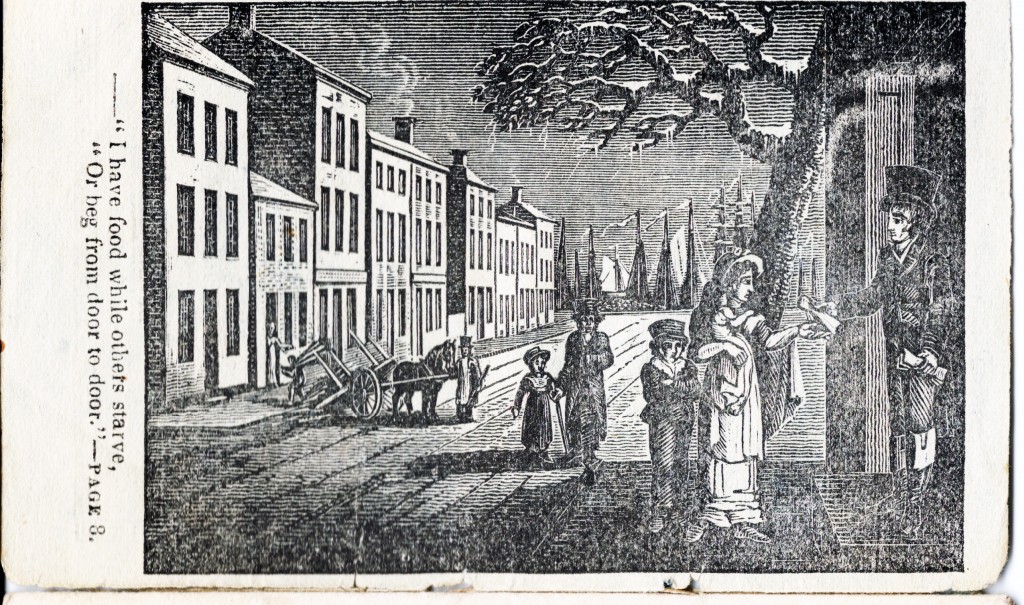 In the intervening week or so since my post on this mysterious image appeared on the AAS blog, I contacted Alexander Anderson scholar and AAS member Jane Pomeroy. She graciously sent me this scanned copy of the full image found in her copy of the Mahlon Day 1830 edition of Divine Songs.
In the intervening week or so since my post on this mysterious image appeared on the AAS blog, I contacted Alexander Anderson scholar and AAS member Jane Pomeroy. She graciously sent me this scanned copy of the full image found in her copy of the Mahlon Day 1830 edition of Divine Songs.
According to Jane, she thinks it is quite possible that the image was directly commissioned by Mahlon Day either in 1830, or right around that time. Jane guesses that the man standing with what could be money or a pile of tracts in his hand is an employee of the house and that the mother with baby and son are needy, but not indigent. Jane brings up the good point that the man in the doorway is not particularly well dressed, and his hat is literally jammed on his head. Jane also thinks it is possible that the coach in the street (better revealed in her copy) carried the woman to the house. We both agree that the scene seems to be set in New York during winter, perhaps Christmas time, and that the object of the image seems to be the importance of providing spiritual/corporal aid to those in need. Finally, Jane’s copy of the image has the telling caption lacking in the imperfect AAS copy:
I have food whole others starve, Or beg from door to door.
Unfortunately, the identity of the engraver is still ambiguous; this image is not among those found in the Alexander Anderson engraving proof books held at New York Public Library. But with Jane’s input, we have a better idea of the image’s meaning.
Further Reading:
If you are interested in learning more about the illustrations that we do know were done by Alexander Anderson, you will definitely want to get your hands on this three volume set.
 Pomeroy, Jane R. Alexander Anderson, 1775-1870, Wood Engraver and Illustrator, an Annotated Bibliography. 3 Volumes. New Castle, DE and Worcester, MA: Oak Knoll Press and The American Antiquarian Society, 2005. [available for purchase from Oak Knoll]
Pomeroy, Jane R. Alexander Anderson, 1775-1870, Wood Engraver and Illustrator, an Annotated Bibliography. 3 Volumes. New Castle, DE and Worcester, MA: Oak Knoll Press and The American Antiquarian Society, 2005. [available for purchase from Oak Knoll]


Great image–and fun detective work.
Just to add…the “coach” in the background is more likely a cart– you can easily see the cartman’s characteristic long white coat and hat. The boy is unloading some goods into a woman’s home (or removing goods?). It’s unlikely that the cart would have carried the people to the street.
I wonder if there was a Sunday morning tradition of alms-giving (with the requisite religious tract) at this time in NYC?
I think the “caption” requires some rethinking. It’s a mistake to over-interpret a fairly crude image. The woman and kids are presumably “beg[ging] from door to door”; the figure in the doorway is a householder giving alms. As Kristen says, he’s probably giving out tracts too (actual alms would be in coin, wouldn’t they?) and that’s probably a cart making a delivery to another comparatively well-off household.
Kristen & Mr. Punch:
Thank you both for your insightful comments. Yes, I think the alms would be distributed as coins; and the cart is probably making a delivery. Charity seems to be the basic message conveyed in the image.
Laura Wasowicz
Mahlon Day printed Religious Tracts. Tracts were distributed by colporteurs to the destitute. The cart may carry the traveling colporteur’s tracts. Read the book Trials and Triumphs of Union Missionary Colportage for Twenty Five Years. The entire engraving and message will make perfect sense. Also search the word “Tracts: on the AAS site. Find the article about Dating American Tract Society Publications. Scroll down below it to find a list of Tract engravers.